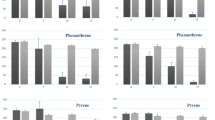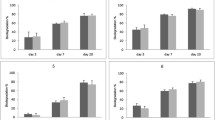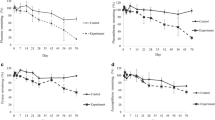Abstract
Estuarine sediments near former creosoting facilities along the Elizabeth River (Virginia, USA) are contaminated by polycyclic aromatic hydrocarbons (PAHs). In this study, we interrogated the bacterial community of the Elizabeth River with both culture-based and culture-independent methods to identify potential candidates for bioremediation of these contaminants. DNA-based stable isotope probing (SIP) experiments with phenanthrene and fluoranthene using sediment from the former Republic Creosoting site identified relevant PAH-degrading bacteria within the Azoarcus, Hydrogenophaga, and Croceicoccus genera. Targeted cultivation of PAH-degrading bacteria from the same site recovered 6 PAH-degrading strains, including one strain highly similar to Hydrogenophaga sequences detected in SIP experiments. Other isolates were most similar to organisms within the Novosphingobium, Sphingobium, Stenotrophomonas, and Alcaligenes genera. Lastly, we performed 16S rRNA gene amplicon microbiome analyses of sediment samples from four sites, including Republic Creosoting, with varying concentrations of PAHs. Analysis of these data showed a striking divergence of the microbial community at the highly contaminated Republic Creosoting site from less contaminated sites with the enrichment of several bacterial clades including those affiliated with the Pseudomonas genus. Sequences within the microbiome libraries similar to SIP-derived sequences were generally found at high relative abundance, while the Croceicoccus sequence was present at low to moderate relative abundance. These results suggest that Azoarcus and Hydrogenophaga strains might be good target candidates for biostimulation, while Croceicoccus spp. might be good targets for bioaugmentation in these sediments. Furthermore, this study demonstrates the value of culture-based and culture-independent methods in identifying promising bacterial candidates for use in a precision bioremediation scheme.
Key points
• This study highlights the importance of using multiple strategies to identify promising bacterial candidates for use in a precision bioremediation scheme.
• We used both selective cultivation techniques and DNA-based stable isotope probing to identify bacterial degraders of prominent PAHs at a historically contaminated site in the Elizabeth River, VA, USA.
• Azoarcus and Hydrogenophaga strains might be good target candidates for biostimulation in Elizabeth River sediments, while Croceicoccus spp. might be good targets for bioaugmentation.




Similar content being viewed by others
Data availability
NCBI Accession Numbers for organisms referenced in text are provided within the text.
Code availability
HTML links to code are cited within text.
References
Altschul SF, Gish W, Miller W, Myers EEWW, Lipman DJ (1990) Basic local alignment search tool. J Mol Biol
Boonchan S, Britz ML, Stanley GA, S B, ML B, GA S (1998) Surfactant-enhanced biodegradation of high molecular weight polycyclic aromatic hydrocarbons by Stenotrophomonas maltophilia. Biotechnol Bioeng 59:482–494.1
Callahan BJ, McMurdie PJ, Rosen MJ, Han AW, Johnson AJA, Holmes SP (2016) DADA2: High-resolution sample inference from Illumina amplicon data. Nat Methods 13:581–583
Chen MH, Sheu SY, James EK, Young CC, Chen WM (2013) Azoarcus olearius sp. nov., a nitrogen-fixing bacterium isolated from oil-contaminated soil. Int J Syst Evol Microbiol 63:3755–3761
Cole J, Wang Q, Cardenas E, Fish J, Chai B, Farris R, Kulam-Syed-Mohideen A, McGarrell D, Marsh T, Garrity G, Tiedje J (2009) The Ribosomal Database Project: improved alignments and new tools for rRNA analysis. Nucleic Acids Res
Corteselli EM, Aitken MD, Singleton DR (2017a) Description of Immundisolibacter cernigliae gen. nov., sp. nov., a high-molecular-weight polycyclic aromatic hydrocarbon-degrading bacterium within the class Gammaproteobacteria, and proposal of Immundisolibacterales ord. nov. and Immundisolibacteraceae f. Int J Syst Evol Microbiol 67:925–931
Corteselli EM, Aitken MD, Singleton DR (2017b) Rugosibacter aromaticivorans gen. Nov., sp. nov., a bacterium within the family Rhodocyclaceae, isolated from contaminated soil, capable of degrading aromatic compounds. Int J Syst Evol Microbiol 67:311–318
Di Giulio RT, Clark BW (2015) The Elizabeth River story: A case study in evolutionary toxicology. J Toxicol Environ Heal Part B 18:259–298
Dunlevy SR, Singleton DR, Aitken MD (2013) Biostimulation reveals functional redundancy of anthracene-degrading bacteria in polycyclic aromatic hydrocarbon-contaminated soil. Environ Eng Sci 30:697–705
Edwards U, Rogall T, Blocker H, Emde M, Bottger E. (1989) Isolation and direct complete nucleotide determination of entire genes. characterization of a gene coding for 16S ribosomal RNA. Nucleic Acids Res
Fahy A, Ball AS, Lethbridge G, Timmis KN, McGenity TJ (2008) Isolation of alkali-tolerant benzene-degrading bacteria from a contaminated aquifer. Lett Appl Microbiol 47:60–66
Fodelianakis S, Antoniou E, Mapelli F, Magagnini M, Nikolopoulou M, Marasco R, Hussein E, Al-Horani F, Benzha F, Blaghen M, Malkawi H, Abdel-Fattah Y, Cherif A, Daffonchio D, Kalogerakis N (2015) Allochthonous bioaugmentation in ex situ treatment of crude oil-polluted sediments in the presence of an effective degrading indigenous microbiome. J Hazard Mater 287:78–86
Gao S, Seo JS, Wang J, Keum YS, Li J, Li QX (2013) Multiple degradation pathways of phenanthrene by Stenotrophomonas maltophilia C6. Int Biodeterior Biodegrad 79:98–104
Gauthier MJ, Lafay B, Christen R, Fernandez L, Acquaviva M, Bonin P, Bertrand JC (1992) Marinobacter hydrocarbonoclasticus gen. nov., sp. nov., a new, extremely halotolerant, hydrocarbon-degrading marine bacterium. Int J Syst Bacteriol 42:568–576
Ghosal D, Ghosh S, Dutta TK, Ahn Y (2016) Current state of knowledge in microbial degradation of polycyclic aromatic hydrocarbons (PAHs): a review. Front Microbiol 7
Gutierrez T, Singleton DR, Aitken MD, Semple KT (2011) Stable isotope probing of an algal bloom to identify uncultivated members of the Rhodobacteraceae associated with low-molecular-weight polycyclic aromatic hydrocarbon degradation. Appl Environ Microbiol 77:7856–7860
Gutierrez T, Singleton DR, Berry D, Yang T, Aitken MD, Teske A (2013) Hydrocarbon-degrading bacteria enriched by the Deepwater Horizon oil spill identified by cultivation and DNA-SIP. ISME J 7:2091–2104
Gutierrez T, Biddle J, Teske A, Aitken M (2015) Cultivation-dependent and cultivation-independent characterization of hydrocarbon-degrading bacteria in Guaymas Basin sediments. Front Microbiol 6
Hilyard EJ, Jones-Meehan JM, Spargo BJ, Hill RT (2008) Enrichment, isolation, and phylogenetic identification of polycyclic aromatic hydrocarbon-degrading bacteria from Elizabeth River sediments. Appl Environ Microbiol 74:1176–1182
Huang Y, Zeng Y, Yu Z, Zhang J, Feng H, Lin X (2013) In silico and experimental methods revealed highly diverse bacteria with quorum sensing and aromatics biodegradation systems - a potential broad application on bioremediation. Bioresour Technol 148:311–316
Huang Y, Zeng Y, Feng H, Wu Y, Xu X (2015) Croceicoccus naphthovorans sp. nov., a polycyclic aromatic hydrocarbons-degrading and acylhomoserine-lactone-producing bacterium isolated from marine biofilm, and emended description of the genus Croceicoccus. Int J Syst Evol Microbiol 65:1531–1536
Jeon C, Park W, Padmanabhan P, DeRita C, Snape J, Madsen E (2003) Discovery of a bacterium, with distinctive dioxygenase, that is responsible for in situ biodegradation in contaminated sediment. Proc Natl Acad Sci 100
Jiao S, Chen W, Wang E, Wang J, Liu Z, Li Y, Wei G (2016) Microbial succession in response to pollutants in batch-enrichment culture. Sci Rep 6
Jones M, Singleton DR, Sun W, Aitken MD (2011a) Multiple DNA extractions coupled to staple-isotope probing of anthracene-degrading bacteria in contaminated soil. Appl Environ Microbiol 77:2984–2991
Jones MD, Crandell DW, Singleton DR, Aitken MD (2011b) Stable-isotope probing of the polycyclic aromatic hydrocarbon-degrading bacterial guild in a contaminated soil. Environ Microbiol 13:2623–2632
Kertesz MA, Kawasaki A (2010) Hydrocarbon-degrading Sphingomonads: Sphingomonas, Sphingobium, Novosphingobium, and Sphingopyxis, p. 1693–1706. In Handbook of Hydrocarbon and Lipid Microbiology
Kiyohara H, Nagao K, Yana K (1982) Rapid screen for bacteria degrading water-insoluble, solid hydrocarbons on agar plates. Appl Environ Microbiol 43:454–457
Kuppusamy S, Thavamani P, Megharaj M, Naidu R (2016) Biodegradation of polycyclic aromatic hydrocarbons (PAHs) by novel bacterial consortia tolerant to diverse physical settings - Assessments in liquid- and slurry-phase systems. Int Biodeterior Biodegrad 108:149–157
Laguerre G, Bossand B, Bardin R (1987) Free-living dinitrogen-fixing bacteria isolated from petroleum refinery oily sludge. Appl Environ Microbiol 53(7):1674–1678. https://doi.org/10.1128/aem.53.7.1674-1678.1987
Lalucat J, Pares R, Schlegel HG (1982) Pseudomonas taeniospiralis sp. nov., an R-Body-Containing Hydrogen Bacterium. Int J Syst Evol Microbiol 32:332–338. https://doi.org/10.1099/00207713-32-3-332
Lambo AJ, Patel TR (2006) Isolation and characterization of a biphenyl-utilizing psychrotrophic bacterium, Hydrogenophaga taeniospiralis IA3-A, that cometabolize dichlorobiphenyls and polychlorinated biphenyl congeners in Aroclor 1221. J Basic Microbiol 46:94–107
Lane DJ (1991) 16S/23S rRNA Sequencing. Nucleic Acid Tech BactSyst 1150175
Launen L, Buggs V, Eastep M, Enriquez R, Leonard J, Blaylock M, Huang J, Haggblom M (2002) Bioremediation of polyaromatic hydrocarbon-contaminated sediments in aerated bioslurry reactors. Bioremediat J 6:125–141
Luo YR, Kang SG, Kim SJ, Kim MR, Li N, Lee JH, Kwon KK (2012) Genome sequence of benzo(a)pyrene-degrading bacterium Novosphingobium pentaromativorans US6-1. J Bacteriol 194:907
Mantri S, Chinthalagiri MR, Gundlapally SR (2016) Description of Hydrogenophaga laconesensis sp. nov. isolated from tube well water. Arch Microbiol 198:637–644
Martin F, Torelli S, Le Paslier D, Barbance A, Martin-Laurent F, Bru D, Geremia R, Blake G, Jouanneau Y (2012) Betaproteobacteria dominance and diversity shifts in the bacterial community of a PAH-contaminated soil exposed to phenanthrene. Environ Pollut 162:345–353
Møller J, Ingvorsen H (1993) Biodegradation of phenanthrene in soil microcosms stimulated by an introduced Alcaligenes sp. FEMS Microbiol Lett 102:271–278
Mueller JG, Chapman PJ, Pritchard PH (1989) Action of a Fluoranthene-Utilizing Bacterial Community on Polycyclic Aromatic Hydrocarbon Components of Creosote 55:3085–3090
Park S, Won SM, Oh TK, Yoon JH (2019) Croceicoccus ponticola sp. nov., a lipolytic bacterium isolated from seawater. Int J Syst Evol Microbiol 69:1551–1556
Patel AB, Singh S, Patel A, Jain K, Amin S, Madamwar D (2019) Synergistic biodegradation of phenanthrene and fluoranthene by mixed bacterial cultures. Bioresour Technol 284:115–120
Pinyakong O, Habe H, Omori T (2003) The unique aromatic catabolic genes in Sphingomonads degrading polycyclic aromatic hydrocarbons (PAHs). J Gen Appl Microbiol 49:1–19
Radajewski S, Ineson P, Parekh N, Murrell J (2000) Stable-isotope proving as a tool in microbial ecology. Nature 403:646–649
Regonne R, Martin F, Mbawala A, Ngassoum M, Jouanneau Y (2013) Identification of soil bacteria able to degrade phenanthrene bound to a hydrophobic sorbent in situ. Environ Pollut 180:145–151
Reinhold-Hurek B, Hurek T, Gillis M, Hoste B, Vancanneyt M, Kersters K, De Ley J (1993) Azoarcus gen. nov., Nitrogen-fixing Proteobacteria associated with roots of Kallar Grass (Leptochloa fusca (L.) Kunth), and description of two species, Azoarcus indigens sp. nov. and Azoarcus communis sp. nov. Int J Syst Evol Microbiol 43:574–584
Romantschuk M, Sarand I, Petnen T, Peltola R, Jonsson-Vihanne M, Koivula T, Haahtela K (2000) Means to improve the effect of in situ bioremediation of contaminated soil: An overview of novel approaches. Environ Pollut 107:179–185
Samanta SK, Singh OV, Jain RK (2002) Polycyclic aromatic hydrocarbons: environmental pollution and bioremediation. Trends Biotechnol 20:243–248
Sanseverino J, Applegate B, King J, Sayler G. (1993) Plasmid-mediated mineralization of naphthalene, phenanthrene, and anthracene. Appl Environ Microbiol
Shahriari Moghadam M, Ebrahimipour G, Abtahi B, Ghassempour A, Seyed Hashtroudi M (2014) Biodegradation of polycyclic aromatic hydrocarbons by a bacterial consortium enriched from mangrove sediments. J Environ Heal Sci Eng 12
Sievers F, Wilm A, Dineen D, Gibson TJ, Karplus K, Li W, Lopez R, McWilliam H, Remmert M, Söding J, Thompson JD, Higgins DG (2011) Fast, scalable generation of high-quality protein multiple sequence alignments using Clustal Omega. Mol Syst Biol 7
Singleton DR, Powell SN, Sangaiah R, Gold A, Ball LM, Aitken MD (2005) Stable-isotope probing of bacteria capable of degrading salicylate, naphthalene, or phenanthrene in a bioreactor treating contaminated soil. Appl Environ Microbiol 71:1202–1209
Singleton DR, Sangaiah R, Gold A, Ball LM, Aitken MD (2006) Identification and quantification of uncultivated Proteobacteria associated with pyrene degradation in a bioreactor treating PAH-contaminated soil. Environ Microbiol 8:1736–1745
Sohn JH, Kwon KK, Kang JH, Jung HB, Kim SJ (2004) Novosphingobium pentaromativorans sp. nov., a high-molecular-mass polycyclic aromatic hydrocarbon-degrading bacterium isolated from estuarine sediment. Int J Syst Evol Microbiol 54:1483–1487
Song M, Luo C, Jiang L, Zhang D, Wang Y, Zhang G (2015) Identification of benzo[a]pyrene-metabolizing bacteria in forest soils by using DNA-based stable-isotope probing. Appl Environ Microbiol 81:7368–7376
Stach JEM, Burns RG (2002) Enrichment versus biofilm culture: a functional and phylogenetic comparison of polycyclic aromatic hydrocarbon-degrading microbial communities. Environ Microbiol 4:169–182
Stringfellow WT, Aitken MD (1994) Comparative physiology of phenanthrene degradation by two dissimilar pseudomonads isolated from a creosote-contaminated soil. Can J Microbiol 40:432–438
Sul WJ, Park J, Quensen JF, Rodrigues JLM, Seliger L, Tsoi TV, Zylstra GJ, Tiedje JM (2009) DNA-stable isotope probing integrated with metagenomics for retrieval of biphenyl dioxygenase genes from polychlorinated biphenyl-contaminated river sediment. Appl Environ Microbiol 75:5501–5506
Sun R, Jin J, Sun G, Liu Y, Liu Z (2010) Screening and degrading characteristics and community structure of a high molecular weight polycyclic aromatic hydrocarbon-degrading bacterial consortium from contaminated soil. J Environ Sci 22:1576–1585
Tiwari B, Manickam N, Kumari S, Tiwari A (2016) Biodegradation and dissolution of polyaromatic hydrocarbons by Stenotrophomonas sp. Bioresour Technol 216:1102–1105
Volkoff SJ, Osterberg JS, Jayasundara N, Cooper EM, Hsu-Kim H, Rogers L, Gehrke GE, Jayaraman S, Di Giulio RT (2019) Embryonic Fundulus heteroclitus responses to sediment extracts from differentially contaminated sites in the Elizabeth River, VA. Ecotoxicology
Wang Q, Garrity GM, Tiedje JM, Cole JR (2007) Naïve Bayesian classifier for rapid assignment of rRNA sequences into the new bacterial taxonomy. Appl Environ Microbiol 73:5261–5267
Willems A, Busse J, Gillis Goor M, Pot B, Falsen E, Jantzen E, Hoste B, Kersters K, Auling G, De Ley J. (1989) Hydrogenophaga, a new genus of hydrogen-oxidizing bacteria that includes Hydrogenophaga flava comb. nov. (formerly Pseudomonas flava), Hydrogenophaga palleronii (formerly Pseudomonas palleronii), Hydrogenophaga pseudoflava (formerly Pseudomonas pseudoflav.) Int J Syst Evol Microbiol 39:319–333
Yan Z, Zhang Y, H W, M Y, Zhang H, Hao Z, Jiang H (2017) Isolation and characterization of a bacterial strain Hydrogenophaga sp. PYR1 for anaerobic pyrene and benzo[a]pyrene biodegradation. RSC Adv 7:46690–46698
Ye J, Coulouris G, Zaretskaya I, Cutcutache I, Rozen S, Madden TL (2012) Primer-BLAST: a tool to design target-specific primers for polymerase chain reaction. BMC Bioinformatics 13:134
Yu K, Wong A, Yau K, Wong Y, Tam N (2005) Natural attenuation, biostimulation and bioaugmentation on biodegradation of polycyclic aromatic hydrocarbon (PAHs) in mangrove sediments. Mar Pollut Bull 51:1071–1077
Yuan J, Lai Q, Sun F, Zheng T, Shao Z (2015) The diversity of PAH-degrading bacteria in a deep-sea water column above the southwest Indian ridge. Front Microbiol 6
Zhang S, Wan R, Wang Q, Xie S (2011a) Identification of anthracene degraders in leachate-contaminated aquifer using stable isotope probing. Int Biodeterior Biodegrad 65:1224–1228
Zhang Z, Sangaiah R, Gold A, Ball LM (2011b) Synthesis of uniformly 13C-labeled polycyclic aromatic hydrocarbons. Org Biomol Chem 9:5431–5435
Funding
This work was funded by the NIEHS supported Duke University Superfund Research Center (P42ES010356) and the National Science Foundation (NSF) under grant DGE 1545220.
Author information
Authors and Affiliations
Contributions
Authors SV, CG, DS, DR, and AM contributed to the study conception and design. Material preparation, data collection, and analysis were performed by SV, DR, DS, and AM. The first draft of the manuscript was written by SV, and all authors commented on previous versions of the manuscript. JS and MA contributed equipment and materials. All authors read and approved the manuscript.
Corresponding author
Ethics declarations
Ethics approval
The authors acknowledge the statement of ethics.
Consent to participate
All authors agreed with the content in this manuscript and gave explicit consent to submit this manuscript in its present form.
Consent for publication
All authors consent to the publication of this manuscript.
Conflicts of interest/Competing interests
The authors have no conflicts of interest to declare that are relevant to the content of this article.
Additional information
Publisher's Note
Springer Nature remains neutral with regard to jurisdictional claims in published maps and institutional affiliations.
Supplementary Information
Below is the link to the electronic supplementary material.
Rights and permissions
About this article
Cite this article
Volkoff, S.J., Rodriguez, D.L., Singleton, D.R. et al. Identifying bioaugmentation candidates for bioremediation of polycyclic aromatic hydrocarbons in contaminated estuarine sediment of the Elizabeth River, VA, USA. Appl Microbiol Biotechnol 106, 1715–1727 (2022). https://doi.org/10.1007/s00253-021-11754-5
Received:
Revised:
Accepted:
Published:
Issue Date:
DOI: https://doi.org/10.1007/s00253-021-11754-5




